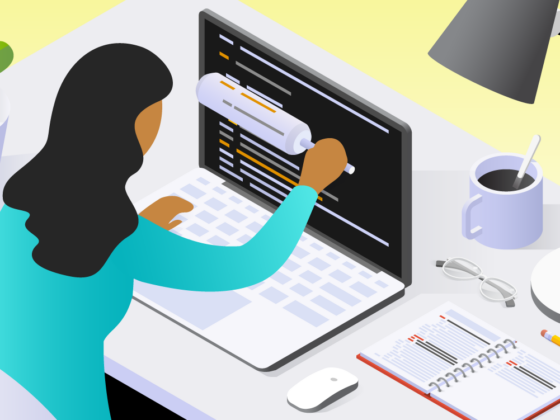Flexion Fundamental 3: Collaborate
“To solve our hardest problems, we encourage real-time discussions, where everyone’s viewpoint is elicited and respected. We expect active engagement to help our teams be present, solve problems, and build relationships.”
By Doug Knesek, Flexion
Introduction
The primary goal of collaboration at Flexion is to generate and evaluate diverse options that create the best outcomes for our clients. This optionality allows Flexion to deliver effective solutions that can evolve.
We match our collaborative strategy to our desired outcome
Effective collaboration can be challenging. Different communication styles and personalities can make reaching the best decision for a situation difficult. Discussing issues in a physical or virtual room is sometimes appropriate, but goal-oriented facilitation is often more helpful.
The collaborative techniques we deploy spring from Agile, Lean, and Design-Thinking practices. Using this deep toolbox, we can search for solutions that provide our clients and ourselves with the best options.
These collaborative strategies and tools can:
- Elicit a range of opinions.
- Converge on one decision quickly.
- Encourage us to deliberate at greater length.
- Help us to listen more carefully.
- Encourage alone time to fire up our imaginations and creativity.
True collaboration requires true inclusion
We seek out employees with diverse backgrounds. But for us to get value from this diversity of thought, everyone has to have the opportunity to engage in open, candid conversations.
Our collaborative methods encourage everyone to participate, including individuals not inclined to be verbal communicators. We seek to catalyze the creativity of our diverse thinkers and shine a spotlight on each individual so they can be heard and seen.
Collective judgment versus consensus building
Although there may be times when building consensus helps solve problems, it can be difficult to achieve, especially when diversity is intentionally embraced. Strong personalities and power dynamics often influence the final opinion.
Flexion prefers to rely on the collective judgment of our employees rather than on consensus.
A culture that embraces diversity assumes and trusts that everyone has some helpful insight into the question. But no one is right all the time. The best decisions and answers come from aggregating individual judgments of a situation. This simple approach is faster, avoids exhausting debate, cancels errors, and provides more accurate results than solely taking the answers from the experts in the room.
Rapid methods for making team decisions
Sometimes teams resist collaborative decision-making because of the time it takes to build consensus through debate and discussion. We recommend using rapid voting methods to make a collective judgment at decision points during a collaboration session to avoid this. Dot voting, Roman polling, and pointing are three methods to try.
- Dot voting
This method was developed in the late 1980s by Swedish organizational consultant Lars-Erik Wennerholm. At Flexion, we use it in various ways to prioritize action items. The number of dots a choice receives determines its rank. - Roman polling
This “thumbs up, thumbs down, thumbs sideways” method is a quick way to get informal feedback or make quick decisions. For example, we take a Roman poll directly after a job interview. Once we’ve decided, interviewers discuss the reasons for their votes. - Pointing
Pointing is a technique used to estimate the importance, size, or value of a task, project, or feature. Participants assign a relative numerical value to the topic under consideration. Often, we use Fibonacci numbers (a sequence in which each number is the sum of the two preceding ones) because they provide a more nuanced estimate than numbers on a linear scale. We compare estimates and discuss until we reach a consensus. We use cards marked with Fibonacci numbers for our most frequently used method of pointing, also known as Planning Poker.
Other collaborative strategies include:
- Liberating Structures
Want everyone on a team to work well together and produce great results? Try one or more of the 33 collaboration techniques,“Liberating Structures,” developed by Henri Lipmanowicz and Keith McCandless. Any of these techniques invite people to work together more creatively and enjoyably. At Flexion, we use a variety of them to encourage inclusion and engagement and inspire the expression of diverse thinking–which is always the goal of our collaborations. - Quarantine & Combine (Q&C)
Q&C is another collaboration, brainstorming, and decision-making technique we frequently use. First, team members work individually or in small groups. Then, they share their outcomes with a larger group to determine the best solution or next steps. Flexion often implements this approach when responding to challenge-style bids. Teams can also use it to evaluate multiple options for approaching any problem. In our Q&C process, we don’t let people talk to each other while in isolation mode because we don’t want groupthink. It also scales well to the scope of the problem. (More time and more people for big problems. Less time and fewer people for minor issues.) - Collaborative Coding (aka “ensemble coding”)
Small groups work together on a specific coding problem. All participants try to understand the problem and contribute directly to the solution. Participants take turns performing different roles within the collaborative coding session. Role constraints under these conditions limit competing positions that may cause stagnation. After a specific time period, participants rotate jobs to give everyone a chance to share their unique perspective. This rotation keeps the team from painting itself into a corner. The rules don’t limit. They enable the collaborating coders to be more efficient and effective. - Isolation
Collaboration can be superpowered when balanced with periods of isolation where we don’t talk to others about project work or ideas. During isolation, we have “head’s down” time, which is time to think deeply. Moving between states of collaboration and isolation creates a powerful space for the imagination to play and creativity to manifest. - Scrum ceremonies
The five official ceremonies of Scrum (counted here as one overall collaborative strategy) are Sprint planning, Daily Scrum, Sprint Review, Sprint Retrospective, and Backlog Refinement. These ceremonies are collaborative by nature and help increase team efficiency and productivity. - Lean Coffee
The Lean Coffee meeting format encourages open conversations. Using a dot voting system, participants put forth topics and work together to prioritize them.
Conclusion
These collaborative techniques are only a sample of those we use at Flexion. Each technique encourages different types of creativity in our employees.
The diverse collection of collaborative techniques increases opportunities to spark imaginative solutions for our clients. These solutions will not only solve the problems clients are experiencing today, but because of our creative approach, these solutions can evolve to meet future needs.
To inquire about partnering with us on public or private sector work, please email sales@flexion.us.
Contact one of our recruiters if you want to work at a company where your unique skills are valued.
Next installment in our Origin Stories series: Flexion Fundamental 4: Design as you go
Next month, we’ll dig into our fourth fundamental and demonstrate how it relates to our core value of maintaining options and optionality.
For the past six years, Doug Knesek has supported Flexion as an agile coach and delivery leader. Over the past thirty years, he has worn nearly all technical and project management hats in the custom applications development domain. Over the last decade, Doug has used his experience to apply the concepts of agility and self-organization to organizational design and evolution.




